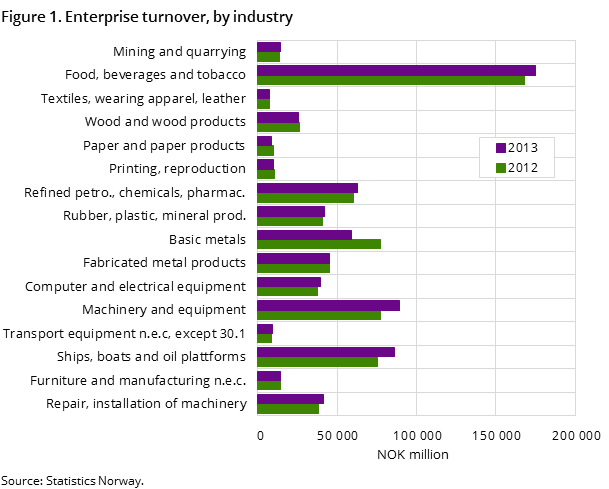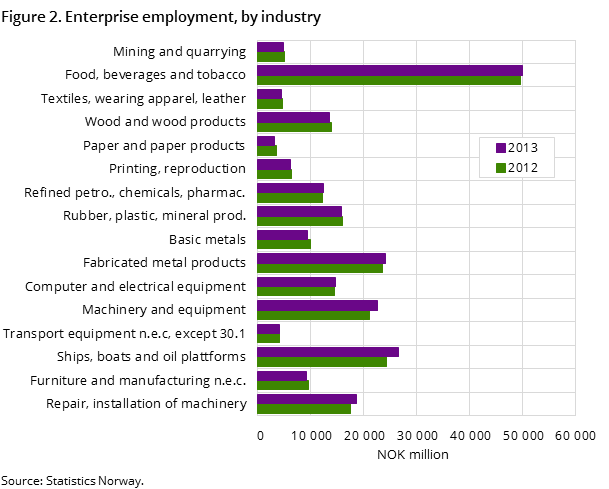Content
Published:
Updated:
This is an archived release.
Moderate increase in manufacturing turnover in 2013
Turnover of enterprises in the manufacturing, mining and quarrying industries increased by 2.7 per cent, from NOK 711 billion in 2012 to NOK 731 billion in 2013. Turnover in the manufacturing industry alone went up from NOK 697 billion to NOK 717 billion, while turnover in mining and quarrying increased from NOK 13.8 billion to NOK 14.2 billion. Growth in turnover in the mining and quarrying industry is mostly due to larger volumes of coal sold.
| Preliminary figures. Enterprises | 2013 | Change | |
|---|---|---|---|
| 2012 - 2013 | 2007 - 2013 | ||
| Number of/NOK million | Per cent | Per cent | |
| Number of enterprises | 17 965 | -1.2 | 4.6 |
| Persons employed | 240 238 | 1.6 | -5.7 |
| Turnover | 730 967 | 2.7 | 3.1 |


The food, beverages and tobacco industry had the highest turnover among manufacturing industries in 2013. The industry had a turnover of NOK 175 billion in 2013; an increase of 4.4 per cent compared to 2012.
Large changes in turnover in some industries
Turnover in the machinery and equipment industry grew by 15.7 per cent from 2012 to 2013. Building of ships, boats and oil platforms also experienced strong growth in 2013, up 13.6 per cent. As in 2012, the paper and paper products industry experienced the largest decline in turnover. From 2012 to 2013, turnover fell by 14.6 per cent.
Turnover figures in the basic metals industry for 2013 will be affected by new accounting principles introduced following the implementation of new guidelines for production of foreign firms (see appendix box below).
Modest growth in employment
The number of employees in manufacturing and mining increased by 1.6 per cent from 2012 to 2013, to almost 240 000 employees.
New guidelines on recording production for foreign enterprisesOpen and readClose
Previously, the entire value of production was included in turnover but from the current publication in 2013, only remuneration for production to other companies will be included following new procedures in national accounts where only remuneration shall be counted, not the entire value of output. The reason for the new guidelines is to avoid double counting in foreign enterprises.
Figures on production values and input will be corrected in the next releaseOpen and readClose
For the preliminary figures for structural business statistics for manufacturing, mining and quarrying 2013, a principle change was made regarding the accounting of processing carried out in Norway where the goods that are further processed are owned by a foreign enterprise. The release of the preliminary figures for 2013 includes figures for the remuneration that the Norwegian companies receive from the processing (net), and not as previously the value of production for others (gross). The decision to change to this net approach will be reversed so that the accounting method is made the same as it was for the statistics up to the year 2012, and as from the release of the final figures for 2013 in April 2015, the figures will be corrected in the statistics. The production value in the metal industry will thus be significantly higher for the year 2013 and the break between 2012 and 2013 as a result of this change will no longer exist. The new accounting method for the statistics for 2013 was introduced to adapt to new international rules for the accounting of processing in the national accounts and balance of payments. The Norwegian national accounts and balance of payments, however, have decided for the moment not to incorporate the new guidelines (net accounting) because this poses great challenges when interpreting the value of Norwegian exports of affected industries, and is not in harmony with the current accounting method in the statistics on foreign trade in goods.
The statistics is now published as Business statistics.
Contact
-
Statistics Norway's Information Centre
E-mail: informasjon@ssb.no
tel.: (+47) 21 09 46 42
